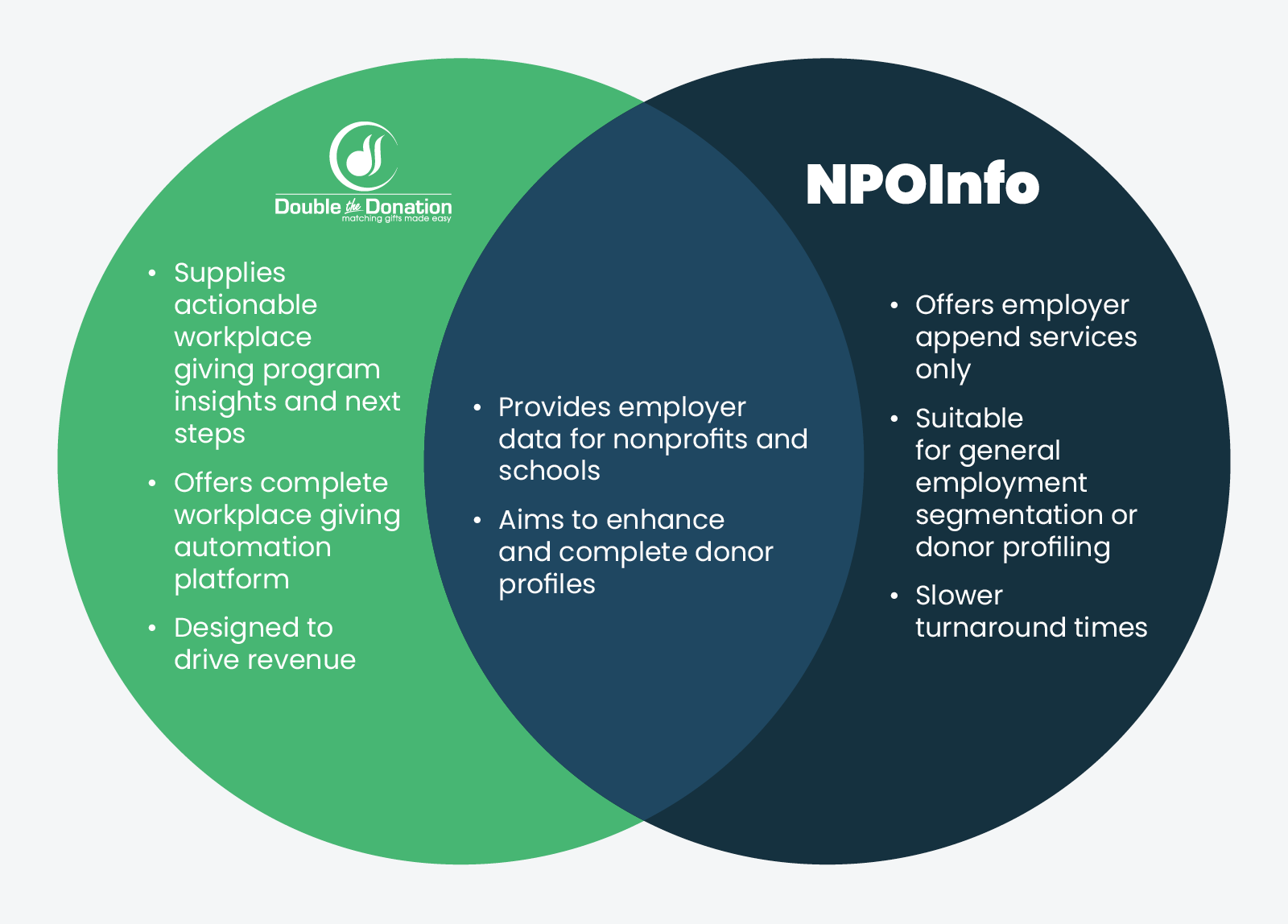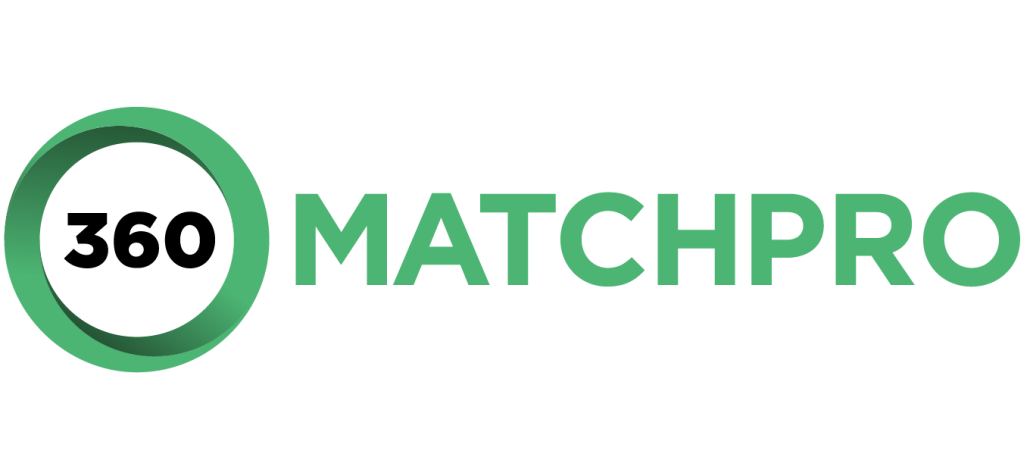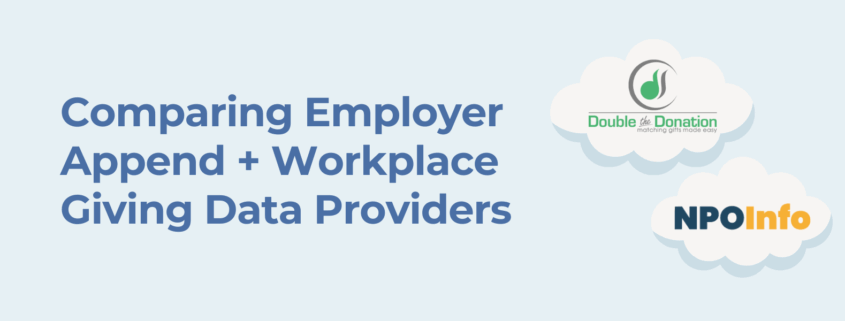Comparing Employer Append + Workplace Giving Data Providers
Are you leaving thousands or even millions of dollars on the table by not knowing where your supporters work? If you’re not leveraging employer append and workplace giving data providers, chances are you are.
In the world of nonprofit fundraising, corporate giving programs, including matching gifts, payroll giving, and volunteer grants, represent a massive yet underutilized revenue stream. According to Double the Donation, an estimated $4–7 billion in matching gifts alone goes unclaimed each year simply because organizations lack the data to identify and follow up with eligible supporters.
The key to unlocking these funds? Accurate employment data—and the tools that help you acquire and act on it. In this blog post, we’ll dive into the basics of employer append services and workplace giving data providers, explore top platforms, and help you determine which solution is best for your nonprofit’s growth strategy.
Specifically, we’ll cover:
- What is an employer append or workplace giving data provider?
- Key features to look for in a workplace giving data provider
- Top workplace giving data providers in the space today
- How to choose the right data provider for your organization’s needs
By understanding the strengths of each type of provider, your organization can make more informed decisions, drive higher workplace giving revenue, and strengthen donor relationships through targeted, data-driven corporate outreach. Whether you’re looking to enhance your donor database or streamline employee giving efforts, this guide will give you the insights you need to choose the right tools and start maximizing your impact today.
Let’s get started.
What is an employer append and workplace giving data provider?
An employer append and workplace giving data provider is a service that helps nonprofits identify where their supporters work—and what corporate giving programs those employers offer.
These dedicated tools use available donor or volunteer information, such as email addresses, giving history, or social media profiles, to match individuals to their employers. This process, known as employment appending, fills critical gaps in your database and provides your organization with the insights needed to unlock matching gifts, volunteer grants, payroll giving, and other corporate philanthropy opportunities.
But the value doesn’t stop at identifying employers. Workplace giving data providers also offer detailed information about each company’s giving programs, including:
- Workplace giving eligibility criteria
- Program guidelines and submission deadlines
- Direct links to workplace giving forms
In short, these services provide both the who (i.e., who your donors work for) and the how (i.e., how to access their company’s giving benefits). Whether you’re calling it an employer append or a workplace giving data provider, the goal is the same: to equip your nonprofit with the data it needs to capture more donations, reduce missed opportunities, and maximize fundraising potential.
Key features to look for in a workplace giving data provider
Not all workplace giving data providers are created equal. Choosing the right one can make the difference between simply filling in the blanks in your database and actively converting those opportunities into real revenue.
To ensure you’re investing in a solution that delivers results, here are the key features to prioritize when evaluating a workplace giving data provider:
1. Employer Append Capabilities
For the best results, choose a provider that’s known for its ability to return accurate, clean donor employment data. This helps fill in the missing information from your database by identifying donor and volunteer workplaces based on available information, like personal contact details and engagement history.
2. Extensive and Accurate Workplace Giving Database
At the heart of every great workplace giving data provider is a comprehensive, up-to-date database of companies and their giving programs. Look for a company that covers tens of thousands of employers, including Fortune 1000 companies, mid-size businesses, and popular local employers. Outdated or incomplete data can mean missed opportunities and frustrated donors.
3. Regular Data Updates
Corporate giving programs frequently change. Companies merge, policies are revised, and deadlines shift. Your provider should offer regularly scheduled or real-time updates to ensure you’re working with the most current information possible. This reduces donor confusion and helps maintain trust, ultimately leading to higher overall conversion rates.
4. Automated Outreach
The best workplace giving tools don’t just provide data; they give you the tools to act on it automatically. As you consider the best platforms for your needs, look for features like:
- Triggered emails to workplace giving-eligible donors
- Auto-filled matching gift and volunteer grant forms
- Personalized follow-ups with employer-specific instructions
These tech-driven features can drastically improve program participation rates and free up significant time for your team.
5. Responsive Support
Implementing a new data platform can be complex. Make sure your provider offers dedicated customer success support, training resources, and onboarding guidance to assist your team through the process.
A knowledgeable, responsive support team is especially critical for smaller nonprofits without large tech departments.
By focusing on these features, you’ll be equipped to select a workplace giving data provider that not only enhances your donor data but also translates that information into meaningful action and increased fundraising success.
Top workplace giving data providers in the space today
With the rise of employer-sponsored giving programs, a growing number of data providers are helping nonprofits identify workplace giving-eligible donors and unlock corporate philanthropy revenue with ease. While there are several key players in the space, two stand out for their capabilities, reach, and usability: Double the Donation and NPO Info.
Below, we break down what each provider offers—and why one consistently leads the pack.

Double the Donation
Double the Donation is widely regarded as the top workplace giving data provider for nonprofits of all sizes. In order to provide organizations with the tools they need to power workplace giving success, Double the Donation goes beyond data delivery; it automates the entire matching gift process from start to finish.
Key Features Include:
- A robust, frequently updated database of 24,000+ companies with comprehensive match program information
- Double the Donation’s complete workplace giving automation platform that identifies matching, volunteer grant, and payroll giving-eligible donors in real time during the engagement process
- Automated outreach emails that guide supporters through the process of submitting workplace giving requests
- Customizable employer search widgets for donation forms, confirmation screens, campaign landing pages, and more
- In-depth analytics dashboards to track workplace giving completions, drop-off points, and overall impact
Why It Stands Out: Double the Donation is designed to be hands-off for nonprofits and frictionless for donors. The combination of real-time workplace giving identification and follow-up automation significantly boosts submission rates, helping organizations recover revenue that would otherwise go unclaimed.
Ideal For: Nonprofits looking to maximize workplace giving revenue by supplementing their donor databases with appended employer information using minimal manual effort.
NPO Info
NPO Info is another workplace giving data provider that focuses on employer appends as a donor data enhancement service. While it does offer employment identification capabilities, it lacks the robust automation, integrations, and donor-facing tools that define top-tier solutions, such as Double the Donation.
Key Features Include:
- Employer append services to match donors with their likely workplaces
- Manual match potential identification based on appended data
- Simple data enrichment reports delivered in bulk
Why It Falls Short: NPO Info is a data-only provider, meaning it doesn’t offer automation, match tracking, donor outreach, or just about anything beyond simple company names. As a result, organizations that use NPO Info will need to take additional manual steps to leverage employer data and follow up with donors, leading to more staff time and fewer matches being completed.
Ideal For: Nonprofits that don’t yet have the budget for full automation tools or want to start by simply enhancing their donor database with employer information.
The Bottom Line
While both Double the Donation and NPO Info serve a valuable purpose in the fundraising ecosystem, Double the Donation is the superior choice for nonprofits that want to actively convert employment data into revenue. Its automation, accuracy, and ease of use make it the gold standard for workplace giving success.
NPO Info may serve as a helpful starting point. However, for sustained impact and scalable growth, investing in a comprehensive solution like Double the Donation is the clear winner.
How to choose the right data provider for your organization’s needs
Selecting a workplace giving data provider isn’t a one-size-fits-all decision. Your organization’s size, fundraising goals, technical infrastructure, and internal capacity all influence which solution will deliver the best return on investment.
To ensure you choose a provider that supports your mission and scales with your growth, follow these essential steps:
1. Audit Your Current Donor Data
Start by evaluating the employment information you already have. If your donor database largely lacks employer details, your priority may be to append that missing data. In this case, a provider offering employer append services can help fill in the gaps.
On the other hand, if you already know where many donors work, a tool that activates that data through automation and workplace giving insights will offer greater value.
2. Clarify Your Fundraising Goals
Before you get started with the appends process, ask yourself these questions:
- What goals do we hope to reach by appending donor employment data?
- Are we aiming to increase workplace giving revenue through matching gifts, volunteer grants, and payroll giving?
- Do we want to track involvement and follow up with donors?
- Are we trying to launch a new workplace giving initiative?
If your goal is donor activation and automation, look for a comprehensive platform that not only appends data but also guides donors through the workplace giving involvement process. Double the Donation, for example, automates outreach and tracks results in real time, making it a powerful tool for growth-focused organizations.
3. Assess Internal Capacity
How much staff time can you realistically dedicate to managing workplace giving data efforts?
If your team is small or already overextended, prioritize a platform with automation and self-service features. Streamlined donor outreach, pre-filled forms, and real-time employer lookups mean your team can do more with less, ultimately saving time while boosting impact.
If you have a larger team with capacity for more manual outreach, a data-only solution may suffice for your immediate needs. But keep in mind, automation consistently drives higher results with less effort.
5. Compare Cost to Expected ROI
It’s easy to focus on the price tag—but the real question is: Will this platform help us bring in more revenue than it costs?
A high-performing data provider can help you recover thousands—or even millions—of dollars in missed matching gifts, volunteer grants, and more. Look for providers that offer ROI calculators, case studies, or success benchmarks so you can understand the potential value. Even a few completed matches each month could fully cover the cost of the platform.
6. Request a Demo and Ask the Right Questions
Before you commit, request a demo to see the platform in action. Then, be sure to ask questions such as these to get a better idea of the solution:
- How frequently is your data updated?
- What automation features do you offer?
- Can you show real examples of increased match revenue?
- How long is the onboarding process, and what support is included?
A good provider will be transparent, helpful, and committed to your success—not just selling software.
By taking a strategic, needs-based approach, your organization can choose a workplace giving data provider that not only strengthens your donor database but also amplifies your fundraising results for years to come.
Wrapping up & additional workplace giving resources
Workplace giving represents one of the most powerful, yet underused fundraising opportunities available to nonprofits today. By utilizing employer append services or workplace giving data providers to enhance your donor database and enhance your outreach, you position your organization to generate more revenue and build stronger corporate connections.
In a world where every dollar matters, don’t let easily accessible funds go unclaimed. Make the strategic decision today to invest in the tools that turn employment data into tangible donations, deeper donor engagement, and mission-critical growth.
Interested in learning more about the impact of workplace giving data on your nonprofit’s bottom line? Check out these additional resources:
- Winning Workplace Giving Strategies & How to Leverage Them. Discover proven strategies to boost your nonprofit’s workplace giving revenue. This post breaks down actionable tips, real-world examples, and tools you can use to engage donors, secure matching gifts, and build lasting partnerships.
- The Value of Donor Employer Information in Workplace Giving. Learn why knowing where your donors work is crucial to unlocking corporate giving opportunities. This article explores how employment data drives matching gift success and how to effectively collect and apply it in your fundraising efforts.
- What is Data Appending? Basics, Benefits, and Best Practices. New to data appending? This guide covers everything you need to know, from what it is to how it can enhance your donor records, improve outreach, and increase revenue. Perfect for teams looking to fill in data gaps and optimize results.




